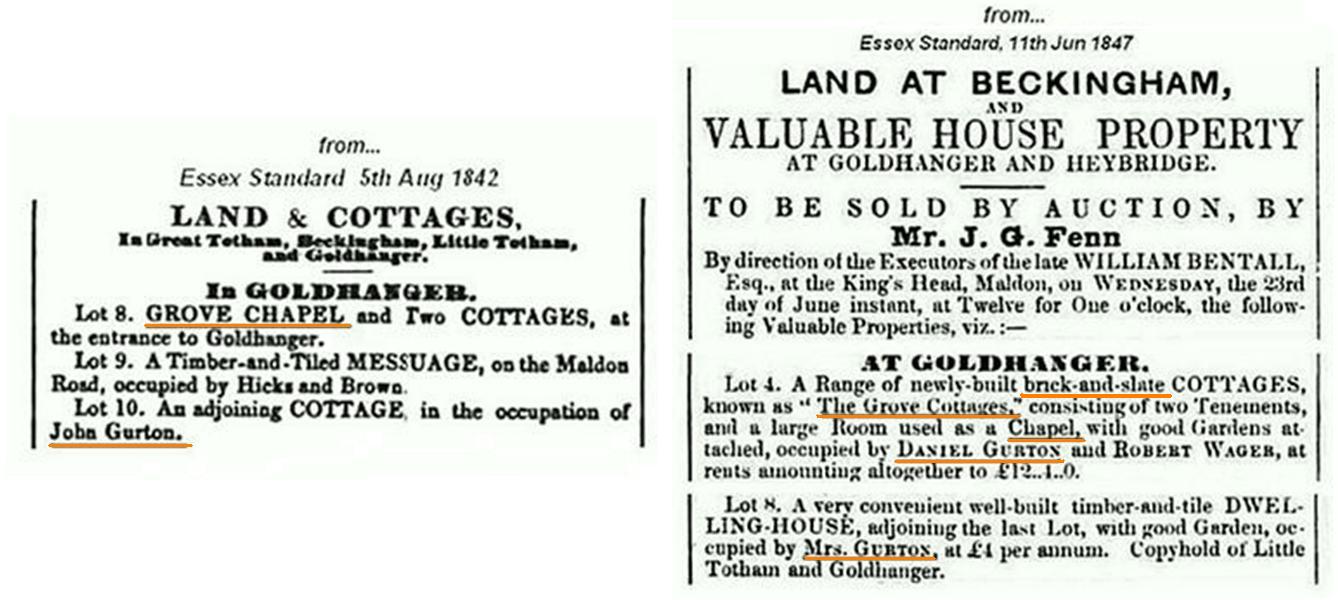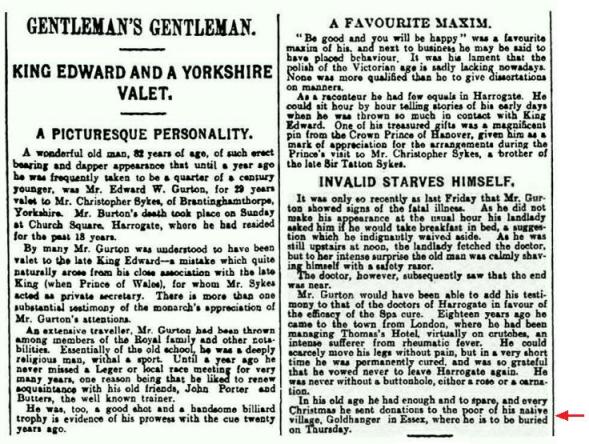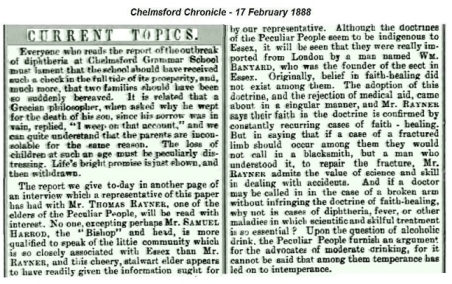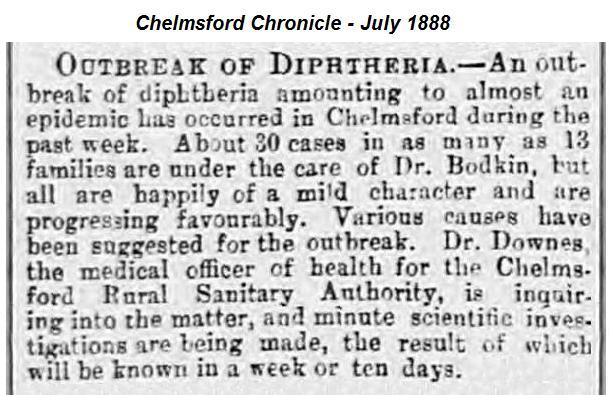The
Gurton Family of Goldhanger
Several members of
the Gurton family lived in and around the village in the 18th and 19th
centuries. They are noted for their association with an apparently non-conformist
chapel that was at one time close to Chappel Farm, and on the boundary between
Goldhanger and Little Totham Parishes. The farm undoubtedly acquired its name
from its association with the chapel. A
member of the Gurton family also created a Trust for the benefit of the village
poor of Goldhanger that is still in operation.
Sources of information
One of the Gurton
gravestones in St Peter’s Church graveyard dated
1888 is dedicated to John & Charlot Gurton. It is also engraved with “and
family”, which is very unusual and one wonders why the family were all buried
together.
The names of
members of the family are known from early Tithe maps and Awards listings, 19th
century census returns and trade directories, and from newspaper adverts and reports. The Gurtons were
a large family with members living in Little Totham, Tolleshunt Major,
Tollesbury, Tillingham and elsewhere. However here we focus only on those
members of the family who lived within the Parish or immediately adjacent to
it.
As well as there
being many members of the Gurton family in the area, the same christian names
were passed down through the family and there were several Edwards, Stephens,
Daniels and Johns and more than one Edward Gurton is identified in this study. No attempt has been make to establish their
relationships.
These two
advertisements from the 1840s to a “Grove Chapel” at Goldhanger...
In 2005 Lorna Key
wrote and published Little Totham - The Story of a small village which includes this
description of Chappel Farm...
Chappel Farm preserves the memory of the
chapel of Little Totham, and was mentioned in 1396 and 1578. The present house
dates from 1812 at the front and the 16th century at the rear...
...The property includes two cottages,
brick, stud and plaster built, thatched, and known as Bobbetts Hole, with
detached brick and tile wash houses fitted with two copper coppers and an
iron-roofed poultry house with a fenced in yard, a capital garden with well and
pump on the opposite side of the road. Bobbets Hole is on the corner just
before Blind Lane with the two cottages, Crabbs Cottages, nearly opposite.
There is more
history of the Grove Chapel at... The Chapel at Chappel
farm
It is known that
several members of the Gurton family where associated with the “Peculiar
Peoples” churches and it seems that the Grove Chapel could have been used as a
Peculiar Peoples Chapel in their day.
The “Peculiar People” and their Chapels
The founder of the
Peculiar Peoples group was James Banyard, who was a farm worker at Rochford in
Essex. He built his first chapel at
Rochford in 1850 (after the Goldhanger Grove Chapel was up for sale in
1842-47). The word peculiar originates
from Latin peculiaris, meaning
special. At that time, peculiar was being used to mean “unusual individuals”.
However the reputation of the members of the sect led to a change in the
meaning of the word to become odd, curious, eccentric, etc.
At the height of
the Peculiar People’s popularity there were 43 chapels, manly in the Essex,
with a few in East London and Kent. In 1956 the Peculiar People’s movement
changed their name to The Union of
Evangelical Churches. Sixteen chapels remain, mostly in Essex. This
photograph of their harvest supper in Shire Hall Chelmsford in 1920 has 700
guests and demonstrates their significance at that time...
The Peculiar People
practised a form of non-conformist evangelical worship and followed a rigid
interpretation of the King James Bible. They practised faith healing and did
not seek medical care in cases of sickness, instead relying only on prayer.
This frequently resulted in deaths, particularly of children, and their parents
were often put on trial following the deaths.
Some parents were
imprisoned after a 1910 diphtheria outbreak in Essex, causing a split within
the church between the 'Old Peculiars', who still rebuffed medicine, and the
'New Peculiars', who reluctantly accepted it. The split eventually ended in the
1930s after the New Peculiar’s stance prevailed. The last newspaper report of a
prosecution in dated 1936 (some newspaper extracts are given below).
It may well be that
a local diphtheria outbreak caused the deaths of children in the Gurton family
and that might explain why one of the graves in St Peters churchyard has
"and Family" engraved on it and that also may well have brought about
the demise of the Grove Chapel. The only graveyard provided especially for
Peculiar Peoples members was at the Dawes Heath chapel and other members of the
sect were usually buried in CoE graveyards.
No photograph of
the Grove Chapel has been found, however there are many photos of other
Peculiar Peoples Chapels in the area. Below are some examples. The nearest
surviving chapel is at Little Totham which was built in 1890. It is now called Little Totham Evangelical Church and it
is known that members of the local Gurton family where associated with this
chapel in the past.
Related religious sects of interest
The Grove Chapel was advertised for sale before
most Peculiar Peoples Chapels were built and as it appears to
have existed for hundreds of years. Therefore, it is likely that the chapel was
originally created to support some other religious movement. Methodists are the
most probable, as the Peculiar Peoples movement originally broke away from
them. More of this in... The Chapel at Chappel farm
The Gurton Trust
In 1913 Edward Walter Gurton established a
Trust to “distribute the interest every Christmas for the benefit of the sick,
ages and poor of the village”.The Trust is still in operation and is registered
at with the Charity Commission with Charity No. 210841. Although he lived the
later part of his life in Harrogate, Edward Walter Gurton chose to be buried at
Goldhanger. Charities
for the sick and poor has more about this.
This is from the Yorkshire Evening Post in 1913…
Other Charitable Trusts that the family may
have been associated with
1820 and 1838
Goldhanger Tithe Awards (shown at the top of this page) both identify a John
Gurton as the occupier of property number 136. That property was owned by William Bentall of Goldhanger plough fame, but from the
maps and other information we know it to be either Charity Farmhouse or Charity
Cottage, both of which are adjacent to the former Scotts & Motts Farm on the Maldon Rd. This farm was owned by
the Witham Poor Trustees who supported the Newland Street Almshouses in Witham.
So it appears that members of the Gurton family were involved with at least
three charitable trusts. See
also... Charities for the sick and poor
Related newspaper extracts from the time
A search has been undertaken for any
references to epidemics that could have struck the local Gurton family. No
specific incident has been discovered, however these references were found...
1880's
a typhoid epidemic in Danbury
1888 a scarlet fever epidemic in London
1889-1890 measles and influenza pandemic affecting
between a third & a half of the UK population
There are also many newspaper articles in the
1800s that reported on Peculiar People members being prosecuted for allowing
their children to die, These reports, shown in chronological order, are perhaps
of significance...
|
This article
describes a “Diana Gurton” of Tillingham giving evidence for the defence of a
father who allowed his daughter to die without medical treatment. |
|
||||
|
This editorial
refers to diphtheria killing two school children at Chelmsford. It goes on to
criticise the “Peculiar Peoples” attitude that it is acceptable to ask for
medical aid to fix broken bones but not to ask them to treat diseases. |
|||||
|
This article refers
to another diphtheria outbreak at Chelmsford in 1888 and reports of 30 cases
affecting 13 families. (1888 is the date on the grave at Goldhanger) |
|
||||
|
This report in
The Times specifically refers to the Peculiar People of Essex being struck
down by the flu and smallpox and says they are disregarding their “”rule of
faith” and calling in the local doctors. |
|
||||
|
Joshua Gurton,
aged six and son of Mark Gurton of Southminster died after a 5-week illness
without medical attention. The parents were members of the local Peculiar
Peoples church. |
|
||||
|
Six years later
the same Mark Gurton of Southminster was speaking in Witham at a “Liberty
section” meeting of the Peculiar People. The article explains that the liberty
section allowed members to seek medical assistance. |
|
||||
A summary of the findings
o Several members of
the Gurton family are buried in Goldhanger Churchyard.
o One of the graves,
dated 1888, is inscribed “and family” which is unusual.
o Property sale adverts
and census returns indicated the family was associated with a “Grove Chapel”.
o That chapel was very
close to Chappel Farm, on the boundary between Goldhanger and Lt.Totham.
o There are references
to a chapel at Chappel Farm in 1396 and 1578.
o This is undoubtedly
where the farm name originates from.
o A published book in
1839 refers to “Lt.Totham Chapel, in the
Parish of Goldhanger”.
o Land
in that area had a long association with trusts for the poor, the Church and
local Rectors.
o Ancient maps indicates
that the chapel was at Bobbets Hole, Wash Lane, Goldhanger.
o The location was once
at a busy crossroads but is now just a bend in the road and the corner of a
field.
o In the 1800s the
Gurton family were members of local “Peculiar Peoples”
Churches.
o In
the late 1800s many Peculiar Peoples chapels were built in Essex, including one
at Lt.Totham.
o The Chapel at Bobbets
Hole pre-dates these chapels, so would have been used by other denominations.
o Methodist
and Antinomians were known to operate locally, so they and others could have
been used it.
o Many
Peculiar Peoples members refused medical help and were prosecuted for the
deaths of their children.
o There
were several epidemics
causing child deaths in the area in the 1880s.
o This could well
accounted for the “and family” wording on the Goldhanger grave.
o In 1913 an Edward
Gurton created the Gurton Trust to
support the poor of the village, which still operates.
o The family may well
have had been involved with other trusts and charitable organisations in the past.
o The chapel at Bobbets
Hole seems to have disappeared at sometime between 1900 and 1942.
References
Goldhanger – an estuary village
- Maura Benham, 1977
Little Totham - The Story of a small village
- Lorna Key, 2005
The Ecclesiastical Legal Guide to Archbishops, Bishops
and their Secretaries - J. S. Hodson, 1839
The Peculiar People - Mark
Sorrel, 1979
A Dream Come True, The Story of of the Little Totham
Evangelical Church - Lesley Shelley, 1990
The Chapel at Chappel farm Characters from
the past home







